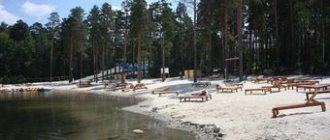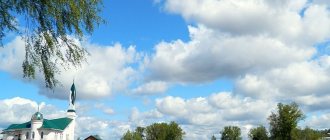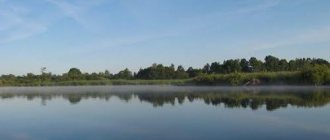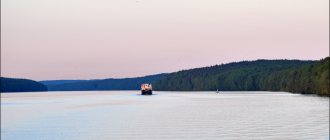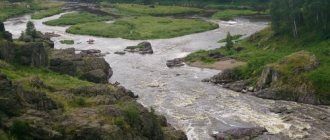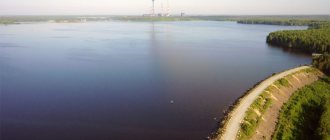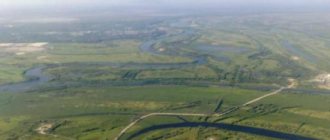Historical reference
Until 1950, the lake had a different name - Suvanto (or Suvanto-järvi). It flowed not into Ladoga, but directly into the river. Vuoksa. On the eastern side of the lake there was a path from Vyborg to Korela (now Priozersk), which was called Vuoksinsky. Since people had to drag ships between these two lakes across the isthmus, a traffic jam developed.
According to historical data, in the 16th century. here was the town of Volochek Svansky, where many traders lived who actively used the portage. In 1741, local residents decided to dig a canal to discharge water into Ladoga. As a result of these efforts, and also with the help of weather phenomena, Sukhodolskoye Lake and Ladoga moved significantly closer to each other (the jumper between them was 50 m).
In 1818, during heavy spring rains, the water in the lakes rose, eroding meadows and fields. But the final point in this matter was put by a strong storm, which washed away the rest of the sandy land. This is how another river appeared - Taipaleen-joki, which is famous for its rapids.
Sukhodolskoe lake history
Until the beginning of the 19th century, Lake Suvanto had a drainage into Vuoksu, and not into Lake Ladoga - between them there was a not very wide sandy ridge covered with forest. There, on the eastern edge of the lake, was the Vuoksa route from Vyborg to Korela (Priozersk). In ancient times, people wanted to shorten its length by creating a portage through the gap between the lakes. It is likely that ships began to be dragged from one lake to another across this isthmus. It is known from census books of the 16th century that the Novgorod city of Volochek Svansky (Suvantsky) with a population of 400-450 people was located on this site. It contained 55 households, 26 of which belonged to merchants. Consequently, a lot of ships used the portage and this gave considerable profit. Initially, Volochek was the property of the Valaam Monastery. Then he was bought by the Moscow princes.
XVIII century
Back in 1741, peasants from local villages began to dig a canal to discharge water into Ladoga and, according to some sources, continued in 1807. Strong westerly winds and precipitation helped this work. As a result, the width of the unflooded bridge between Lake Suvanto and Ladoga was reduced to 50 m.
Vuoksa River
In the spring of 1818, the water level in local lakes rose sharply due to heavy rains and rapid melting of snow. Water flooded nearby fields and meadows. On the night of May 18-19, a storm broke out, the water destroyed the sandy bridge and washed out the canal all the way to Ladoga. The water level in the lake quickly dropped by 7 meters. Therefore, the flow of water to Vuoksa stopped. As a result, the Taipaleenjoki River (Finnish: Taipaleenjoki, now Burnaya) with large rapids was formed. The new river was named after the nearest village - Taipale.
Suvanto's breakthrough into Ladoga brought serious changes to the surrounding territories. After 1818, a drained strip of the lake bottom appeared on the surface, in some places reaching a width of 2 km. As a result of falling water levels, about 5,000 hectares of land were drained. It was covered with bottom silt, which is rich in various organic substances. The land was extremely fertile and most of it was allocated to meadows and arable land for peasants from the surrounding villages. The coastline can be found 30-50 meters from the railway track down in the village of Sukhodolye . A stone ridge, followed by flat clearings - former coastal shallows.
During the Soviet-Finnish “winter” war, the front passed along Lake Suvanto-Jarvi, but apart from artillery shelling from the southern shore, no other military operations took place in this area. In the spring of 1940, according to the Moscow Peace Treaty, the territory of the Karelian Isthmus, including Suvanto-Jarvi, was transferred by Finland to the Soviet Union.
In 1944, under the terms of the Moscow Armistice, the territory was transferred to the USSR for the second time.
In 1950, Lake Suvanto-Jarvi was renamed Sukhodolskoye.
Fishing
Many anglers consider Lake Sukhodolskoye to be the most fishy place. Fishing here pleases with a variety of catches. They can fish both from a boat and from the shore. This is possible due to the presence of sharp drops, which create good conditions for casting a spinning rod and fishing rod to great depths.
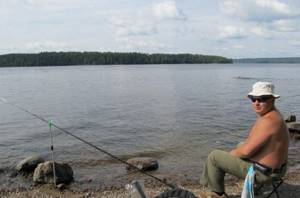
The best places for fishing from the shore are:
- channel mouth (radius 100 m);
- cape, which is located opposite the channel;
- the coast of the lake, located 300 m north of the Losevo railway station.
It must be remembered that the current here is quite strong, so it is recommended to use only special gear. In this place, fishermen will be pleased with the catch of ide and bream, roach and silver bream. Burbot also sometimes hunts for live bait.
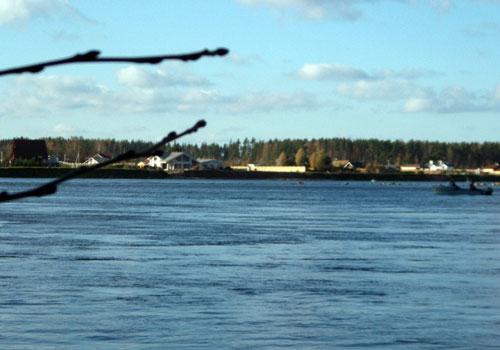
As for fishing on a boat, it is done at considerable depth. The best gear for such fishing will be a ring and a feeder. Worms and maggots are used as bait, for which sabrefish and bream weighing 200-800 grams are excellent. Fishermen also use a fishing rod with a regular float, which can be used to catch bream up to 3 kg in deep dumps. The most favorable time for this is May-October, and especially the middle and end of summer. In early spring, you can catch dace and whitefish with a fishing rod. For pike fishing, fishermen prefer the eastern and middle parts of Lake Sukhodolskoye. Large pike weighing 2-4 kg are found here. Quite often in the shallows you can find roach, sabrefish and even trout.
Fishing on Lake Sukhodolskoe
Fishing for bream on Lake Sukhodolskoye
The largest bream (2 - 3 kg) are found opposite the confluence of the channel, on deep dumps. The current there is very strong, and the depths are significant, this creates many problems when fishing.
Bream on Lake Sukhodolskoye is caught from May to October with a peak in July-August.
Away from the shore, bream can be caught throughout the warm season.
In the spring, the bait catches whitefish and dace. In winter, Lake Sukhodolskoye is of interest to lovers of roach and small burbot.
Fishing for ide on Lake Sukhodolskoe
At the end of spring - beginning of summer, a fairly large ide is caught near the mouth of the channel (place of reverse currents and whirlpools 50 - 100 m north of the point of confluence of the channel, 20 - 50 m from the shore).
The best bait for catching ide is a burdock larva.
In addition to ide, other fish also come to this place: whitefish, large roach, dace, grayling, trout.
Pike fishing on Sukhodolsky
Fans of pike fishing will enjoy the middle and eastern parts of the lake. In these places you can catch pike weighing 2-4 kg.
The source of the river is located in the eastern part of Lake Sukhodolskoye. Stormy. Fishing in the river is licensed (whitefish, grayling).
Sukhodolskoe Lake itself in this area is rich in large roach, bream and large ide. Quite a lot of pike and perch. Trout are often caught.
Fishing from the shore in these places is quite problematic; you need to have your own boat, since there are no boat stations.
From a boat, using a float rod, you can catch roaches and roaches on the shallows near the reeds. Sometimes you come across a small bream. Quite a lot of bleak.
In deeper places, on dumps in numerous holes, you can successfully catch bream and large roach.
In the pits at the source of the river you can catch quite large ide.
The most popular tackle in these places is the donka and feeder.
Winter fishing on the lake
If in summer perch is extremely rare, and not very large in size, then in winter it will delight any fisherman. At great depths (3-5 m) it is caught with a spoon or jig. Also at this time of year, large roach fish well at depths of 5 meters. But the fishermen’s most impressive catch comes from burbot, for which Lake Sukhodolskoye is an excellent habitat. Unfortunately, bream is very difficult to catch in winter.

Story
Until the beginning of the 19th century, Lake Suvanto had a drainage into Vuoksu, and not into Lake Ladoga - between them there was a not very wide sandy ridge covered with forest. The Vuoksa route from Vyborg to Korela (Priozersk) passed through the eastern edge of the lake. In ancient times, people wanted to shorten its length by creating a portage across the isthmus between the lakes. It is likely that ships began to be dragged from one lake to another across this isthmus. It is known from census books of the 16th century that the Novgorod city of Volochek Svansky (Suvantsky) with a population of 400-450 people was located on this site. There were 55 households in it, 26 of which belonged to merchants. Consequently, a lot of ships used the portage and this gave considerable profit. Initially, Volochek was the property of the Valaam Monastery. Then he was bought by the Moscow princes.
The next stage was at the end of the 18th century. Back in 1741, peasants from local villages began to dig a canal to discharge water into Ladoga and, according to some sources [ source not specified 2803 days
], continued in 1807. Strong westerly winds and precipitation helped this work. As a result, the width of the unflooded bridge between Lake Suvanto and Ladoga was reduced to 50 m.
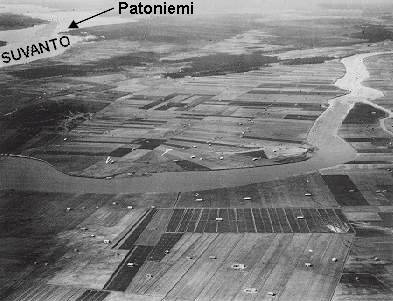
(until 1939) In the spring of 1818, the water level in local lakes rose sharply due to heavy rains and rapid melting of snow. Water flooded nearby fields and meadows. On the night of May 18-19, a storm broke out, the water destroyed the sandy bridge and washed out the canal all the way to Ladoga. The water level in the lake quickly dropped by 7 m, so the flow of water to Vuoksa stopped. As a result, the Taipaleenjoki River (Finnish: Taipaleenjoki, now Burnaya) with large rapids was formed. The new river was named after the nearest village - Taipale.
Suvanto's breakthrough into Ladoga brought serious changes to the surrounding territories. After 1818, a drained strip of the lake bottom appeared on the surface, in some places reaching a width of 2 km. As a result of falling water levels, about 5,000 hectares of land were drained. It was covered with bottom silt, which is rich in various organic substances. The land was extremely fertile and most of it was allocated to meadows and arable land for peasants from the surrounding villages. Today, the old coastline can be found 30-50 meters from the railway track down in the village of Sukhodolye. A stone ridge, followed by flat clearings - former coastal shallows.
During the Soviet-Finnish “winter” war, the front passed along Lake Suvanto-Jarvi, but apart from artillery shelling from the southern shore, no other military operations took place in this area. In the spring of 1940, according to the Moscow Peace Treaty, the territory of the Karelian Isthmus, including Suvanto-Jarvi, was transferred by Finland to the Soviet Union.
In 1944, under the terms of the Moscow Armistice, the territory was transferred to the USSR for the second time.
In 1950[1] Lake Suvanto-Jarvi was renamed Sukhodolskoye.
Where to relax
Among the large number of resort areas, the Vokhotka BO is usually distinguished. On the territory of the base there are modern cottages located on 5 lines, a guarded parking lot, wooden baths and sports grounds. You can get to the recreation center “Vokhodka” from St. Petersburg along the A129 highway (Priozerskoe highway) up to 68 km, then turn onto the road leading to the village of Olkhovka.
Also near the lake there is a cottage-club “Brusnika”. It has six wooden cottages, many gazebos, volleyball and children's playgrounds, and a clubhouse (there are darts and table tennis). The cottage club is located in a pine forest with access to Lake Sukhodolskoe. The entrances to Brusnika are as follows:
- by road along Priozerskoye Highway up to 77 km, before the railway crossing turn right and drive about another 2 km;
- by rail by train to Losevo station, and from there by road;
- by bus (K-859) from Devyatkino station to the Ovragi stop.
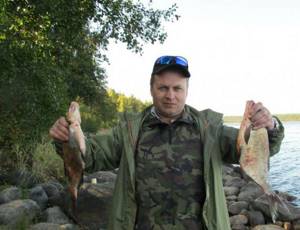
The Molodeznoye BO is ideal for a family holiday, which is located opposite the Losevskie rapids in a pine forest near the shore of Lake Sukhodolskoye. There is a good beach, sauna, artesian water. You can get to your destination along the Priozerskoye Highway (up to 78 km), then you need to turn right and drive about another 2 km.
How to get there?
Sukhodolskoye Lake is part of the Vuoksa lake-river system. Located in the north of the Karelian Isthmus. The lake originates from the Losevskaya Channel, stretching from west to east for 30 km, where it flows into Lake Ladoga through the Burnaya River.

The lake has a very advantageous location; anyone can get to it. You can do this by car or by train, which runs from Finlyandsky Station to Losevo or Gromovo stations.
On the lake, anyone will find a place to their liking. There are numerous tourist centers around the lake where you can rent a boat. Fans of extreme recreation come here to try their hand at rafting the Losevsky rapids.
